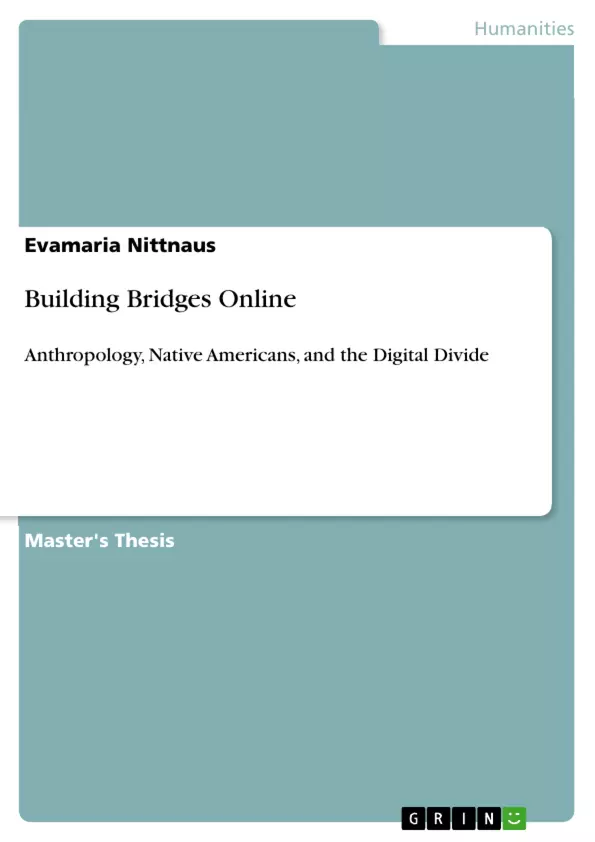In this thesis, written to reach the Swiss equivalent of a MA degree, I will attempt to highlight three main topics, which I propose show some interesting developments and possibilities for today’s anthropologists: 1) that anthropology offers a methodology well-suited to look at the way people behave online; 2) that the digital divide has to be seen as complex reality with more than one dimension; and 3) that, despite all the (mostly justified) criticism and pessimism, the Internet offers many possibilities for those on the margins of a globalized society. For the latter I have chosen the Internet experience of Native Americans, who are in an especially interesting situation because they live in one of the best- connected countries in the world, yet face a number of challenges when it comes to accessing and using the Internet. These three dimensions will be described and analyzed in this thesis, using available research literature, Internet sources and a questionnaire I posted on a website created specifically for my thesis project, because it felt important to me to get some first-hand information as well, at least in a limited way.
Inhaltsverzeichnis (Table of Contents)
- Prologue
- Part I: Introduction
- Taking Anthropology Online
- Studying the Digital Divide
- Statistics
- The Digital Divide Debate
- Appropriation instead of Marginalization
- Part II: Going Online
- Studying the Net: A How-To Guide
- "Native Americans": Some Remarks on Terminology
- Focus: Native American Internet Presence
- Some Problematic Issues
- Examples
- Oneida Nation
- Gila River Community
- Navajo Nation
- The 4D Project
- Further Examples
- Native American Webmasters: A Questionnaire
- Preliminary Remarks
- The Questionnaire
- Basic Information
- Native Americans and the Internet
- First Conclusions
- Part III: Bridging the Digital Divide
- Ethnicity Online: Using the Internet
- "Ethnicity": Choosing Appropriate Terminology
- Appropriating the Internet
- Some Numbers
- Chances and Challenges
- Closing the Gaps: Some Thoughts on Policy
- Digital Development
- Digital Democracy
- Digital Culture
- Digital Inclusion
Zielsetzung und Themenschwerpunkte (Objectives and Key Themes)
This thesis aims to explore the application of anthropological methodology to the study of online behavior, analyze the multifaceted nature of the digital divide, and demonstrate the potential of the internet for marginalized communities, focusing on the case of Native Americans. The author investigates how Native Americans, despite residing in a technologically advanced country, face unique challenges in accessing and utilizing the internet.
- The applicability of anthropological methods to online behavior
- The complex reality of the digital divide, with multiple dimensions
- The internet's potential for bridging the digital divide and empowering marginalized communities
- The unique internet experiences of Native Americans in the United States
- The challenges and opportunities associated with Native American online presence
Zusammenfassung der Kapitel (Chapter Summaries)
The prologue introduces the three main themes of the thesis: the use of anthropology in online research, the complexities of the digital divide, and the internet's potential for marginalized groups, exemplified by Native Americans. Chapter 2, "Taking Anthropology Online," discusses the relevance of anthropological perspectives and methodologies in studying online interactions and communities. Chapter 3, "Studying the Digital Divide," explores the statistical data surrounding the digital divide and the ongoing debate surrounding its definition and implications. Chapter 4, "Appropriation instead of Marginalization," delves into the possibilities for marginalized communities to use the internet to their advantage, highlighting the potential for empowerment and self-representation.
Chapter 5, "Studying the Net: A How-To Guide," provides practical advice and methods for conducting research online. Chapter 6, "Native Americans": Some Remarks on Terminology," discusses the complexities of terminology when discussing Native American communities. Chapter 7, "Focus: Native American Internet Presence," examines the presence of Native American communities online, including examples of online initiatives and the challenges they face. Chapter 8, "Ethnicity Online: Using the Internet," explores the use of the internet as a platform for ethnic identity expression and cultural representation, including the challenges and opportunities associated with this.
Schlüsselwörter (Keywords)
This thesis explores the intersection of anthropology, the digital divide, and the internet, focusing on the experiences of Native Americans in the United States. The key concepts include: online ethnography, digital divide, internet access, Native American internet presence, cultural appropriation, digital inclusion, policy implications, and online communities.
- Arbeit zitieren
- Evamaria Nittnaus (Autor:in), 2006, Building Bridges Online, München, GRIN Verlag, https://www.grin.com/document/179827



